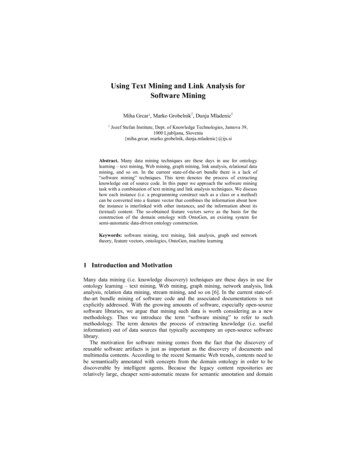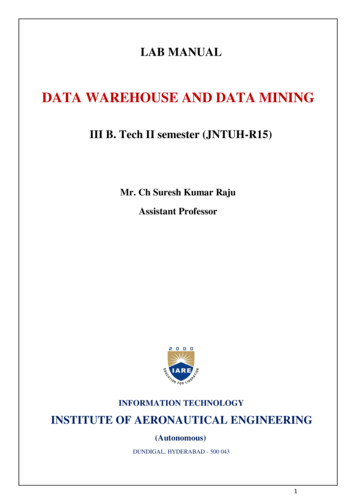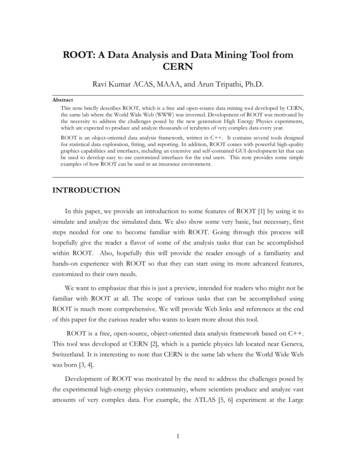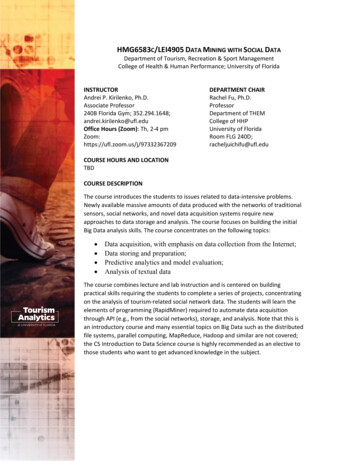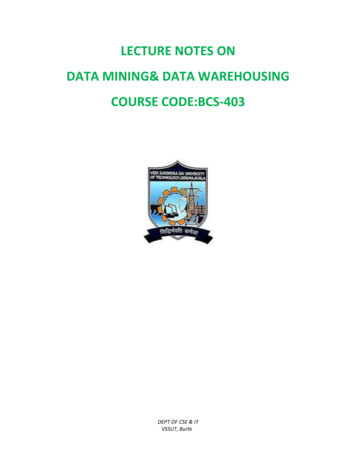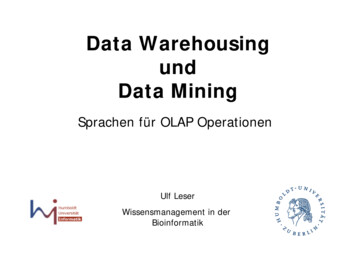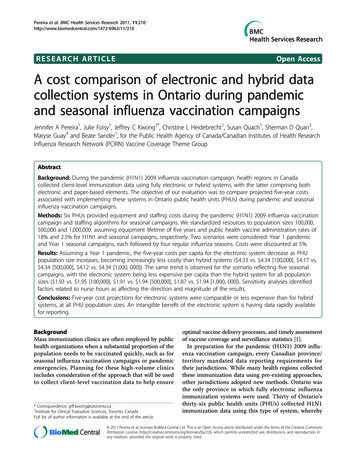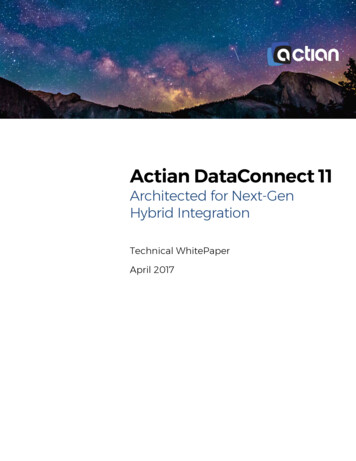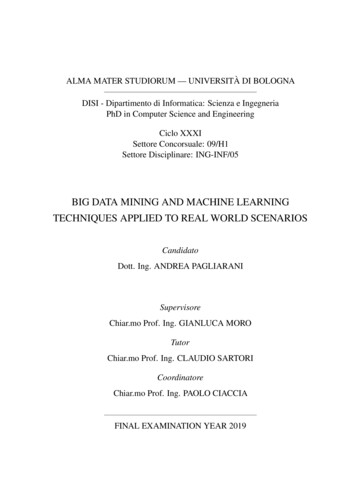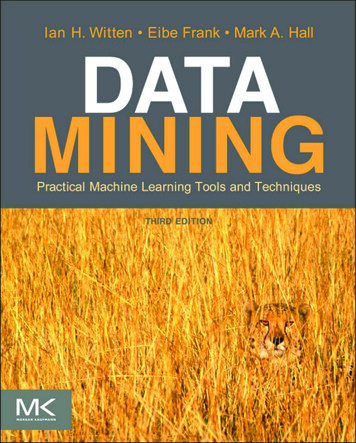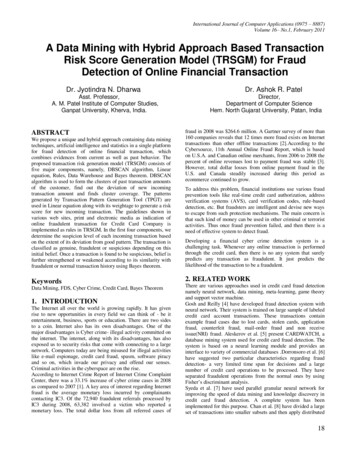
Transcription
International Journal of Computer Applications (0975 – 8887)Volume 16– No.1, February 2011A Data Mining with Hybrid Approach Based TransactionRisk Score Generation Model (TRSGM) for FraudDetection of Online Financial TransactionDr. Jyotindra N. DharwaAsst. Professor,A. M. Patel Institute of Computer Studies,Ganpat University, Kherva, India.ABSTRACTWe propose a unique and hybrid approach containing data miningtechniques, artificial intelligence and statistics in a single platformfor fraud detection of online financial transaction, whichcombines evidences from current as well as past behavior. Theproposed transaction risk generation model (TRSGM) consists offive major components, namely, DBSCAN algorithm, Linearequation, Rules, Data Warehouse and Bayes theorem. DBSCANalgorithm is used to form the clusters of past transaction amountsof the customer, find out the deviation of new incomingtransaction amount and finds cluster coverage. The patternsgenerated by Transaction Pattern Generation Tool (TPGT) areused in Linear equation along with its weightage to generate a riskscore for new incoming transaction. The guidelines shown invarious web sites, print and electronic media as indication ofonline fraudulent transaction for Credit Card Company isimplemented as rules in TRSGM. In the first four components, wedetermine the suspicion level of each incoming transaction basedon the extent of its deviation from good pattern. The transaction isclassified as genuine, fraudulent or suspicious depending on thisinitial belief. Once a transaction is found to be suspicious, belief isfurther strengthened or weakened according to its similarity withfraudulent or normal transaction history using Bayes theorem.KeywordsData Mining, FDS, Cyber Crime, Credit Card, Bayes Theorem1. INTRODUCTIONThe Internet all over the world is growing rapidly. It has givenrise to new opportunities in every field we can think of - be itentertainment, business, sports or education. There are two sidesto a coin. Internet also has its own disadvantages. One of themajor disadvantages is Cyber crime- illegal activity committed onthe internet. The internet, along with its disadvantages, has alsoexposed us to security risks that come with connecting to a largenetwork. Computers today are being misused for illegal activitieslike e-mail espionage, credit card fraud, spasm, software piracyand so on, which invade our privacy and offend our senses.Criminal activities in the cyberspace are on the rise.According to Internet Crime Report of Internet Crime ComplaintCenter, there was a 33.1% increase of cyber crime cases in 2008as compared to 2007 [1]. A key area of interest regarding Internetfraud is the average monetary loss incurred by complainantscontacting IC3. Of the 72,940 fraudulent referrals processed byIC3 during 2008, 63,382 involved a victim who reported amonetary loss. The total dollar loss from all referred cases ofDr. Ashok R. PatelDirector,Department of Computer ScienceHem. North Gujarat University, Patan, Indiafraud in 2008 was 264.6 million. A Gartner survey of more than160 companies reveals that 12 times more fraud exists on Internettransactions than other offline transactions [2].According to theCybersource, 11th Annual Online Fraud Report, which is basedon U.S.A. and Canadian online merchants, from 2006 to 2008 thepercent of online revenues lost to payment fraud was stable [3].However, total dollar losses from online payment fraud in theU.S. and Canada steadily increased during this period asecommerce continued to grow.To address this problem, financial institutions use various fraudprevention tools like real-time credit card authorization, addressverification systems (AVS), card verification codes, rule-baseddetection, etc. But fraudsters are intelligent and devise new waysto escape from such protection mechanisms. The main concern isthat such kind of money can be used in other criminal or terroristactivities. Thus once fraud prevention failed, and then there is aneed of effective system to detect fraud.Developing a financial cyber crime detection system is achallenging task. Whenever any online transaction is performedthrough the credit card, then there is no any system that surelypredicts any transaction as fraudulent. It just predicts thelikelihood of the transaction to be a fraudulent.2. RELATED WORKThere are various approaches used in credit card fraud detectionnamely neural network, data mining, meta-learning, game theoryand support vector machine.Gosh and Reilly [4] have developed fraud detection system withneural network. Their system is trained on large sample of labeledcredit card account transactions. These transactions containexample fraud cases due to lost cards, stolen cards, applicationfraud, counterfeit fraud, mail-order fraud and non receiveissue(NRI) fraud. Aleskerov et al. [5] present CARDWATCH, adatabase mining system used for credit card fraud detection. Thesystem is based on a neural learning module and provides aninterface to variety of commercial databases .Dorronsoro et al. [6]have suggested two particular characteristics regarding frauddetection- a very limited time span for decisions and a largenumber of credit card operations to be processed. They haveseparated fraudulent operations from the normal ones by usingFisher’s discriminant analysis.Syeda et al. [7] have used parallel granular neural network forimproving the speed of data mining and knowledge discovery incredit card fraud detection. A complete system has beenimplemented for this purpose. Chan et al. [8] have divided a largeset of transactions into smaller subsets and then apply distributed18
International Journal of Computer Applications (0975 – 8887)Volume 16– No.1, February 2011data mining for building models of user behavior. The resultantbase models are then combined to generate a meta-classifier forimproving detection accuracy. V.Hanagandi et al. [9] generate afraud score using the historical information on credit card accounttransactions. They describe a fraud-non fraud classificationmethodology using radial basis function network (RBFN) with adensity based clustering approach. The input data is transformedinto cardinal component space and clustering as well as RBFNmodeling is done using a few cardinal components. A.Shen et al.[10] investigates the efficacy of applying classification models tocredit card fraud detection problems. They tested threeclassification methods i.e. neural network, decision tree andlogistic regression for their applicability in fraud detections.H.shao et al. [11] introduced an application in data mining todetect fraud behavior in customs declarations data and used datamining technology such as an easy-to-expand multi-dimensioncriterion data model and a hybrid fraud-detection strategy. A.Srivastava et al. [12] model the sequence of operations in creditcard transaction processing using Hidden Markov Model (HMM)and show how it can be used for detection of frauds. An HMM isinitially trained with normal behavior of card holder. If anincoming credit card transaction is not accepted by trained HMMwith sufficiently high probability, it is considered to be fraudulent.At the same time they also try to ensure that genuine transactionsare not rejected. J.Quah et al. [13] focuses on real time frauddetection and presents a new and innovative approach inunderstanding spending patterns to decipher potential fraud cases.They make use of self organizing map to decipher, filter andanalyze customer behavior for detection of fraud. Recently frauddetection system is developed by Suvasini Panigrahi et al. [14],which consist of four components, namely, rule-based filter,Dempster-Shafer adder, transaction history database and Bayesianrule. In the rule based component, they determine the suspicionlevel of each incoming transaction based on the extent of itsdeviation from good pattern. Dempster-Shafer theory is used tocombine multiple such evidences and an initial belief iscomputed.S.J.Stoflo et al. [15] developed the JAM distributed data miningsystem for the real world problem of fraud detection in financialinformation systems. They have shown that cost-based metrics aremore relevant in certain domains, and defining such metrics posessignificant and interesting research questions both in evaluatingsystems and alternative models, and in formalizing the problemsto which one may wish to apply data mining technologies.Researchers also published some survey papers in the area offraud detection. Phua et al. [16] presented a comprehensive reportusing an extensive survey of data mining based Fraud DetectionSystems and. Kou et al. [17] have compared and measuredperformance of various fraud detection techniques for credit cardfraud, telecommunication fraud and computer intrusion detection.Bolton and Hand [18] identified the tools available for statisticalfraud detection and areas in which fraud detection technologiesare most commonly used. D.W.Abbott et al. [19] compare five ofthe most highly acclaimed commercial data mining tools on afraud detection application, with descriptions of their distinctivestrengths and weaknesses, based on the lessons learned by theauthors during the process of evaluating the products.There are two types of data mining techniques, Unsupervised andSupervised Methods. Unsupervised methods do not need the priorknowledge of fraudulent and non-fraudulent transactions inhistorical database, but instead detect changes in behavior orunusual transactions. Supervised methods require accurateidentification of fraudulent transactions in historical databases andcan only be used to detect frauds of a type that have previouslyoccurred. An advantage of using unsupervised methods oversupervised methods is that previously undiscovered types of fraudmay be detected.The main concern in this domain is that genuine transaction mightnot be caught as fraudulent transaction otherwise it createsinconvenience and dissatisfaction to customer. In the same way,fraudulent transaction should not go undetected otherwise thefinancial company has to suffer lot of money.It is well known that every card holder has certain purchasinghabits. Generally they repeat their shopping habits. Most of theFDS try to find the deviation from this good pattern by onlyimplementing rules or with the similarity from past fraudulenttransaction set. However these rules are largely static in nature, iffraudsters develop or learn new methods and tactics to evadedetection by FDS, then new types of fraud may get unnoticed.Thus system which is not dynamic and able is adapt to newchange, may become outdated resulting in large number of falsealarms. So there is a need of developing new system whichintegrates all the multiple evidences of past genuine andfraudulent transaction set and also focus current dynamic behaviorof customer.We propose a hybrid model containing data mining techniques,statistics and artificial intelligence to collect and combine all themultiple evidences. The model not only considers the pastbehavior but also monitors the current behavior very closely. Thecurrent behavior is stored in the different lookup tables. Wheneverany deviation other than normal behavior found it is furtherchecked with fraudulent transaction history with bayes theorem.To the best of our knowledge, this is first ever attempt to developfinancial cyber crime detection system using hybrid approach likedata mining, statistics and artificial intelligence.The rest of paper is organized as follows. We discuss thetransaction pattern generation tool in brief in section 3. Section 4describes proposed transaction risk score generation model alongwith its methodology. Section 5 shows the result as scatter graphin terms of clusters formed by DBSCAN algorithm.Implementation environment and result analysis & discussions arecovered in section 6 and 7 respectively. Finally we conclude insection 8.3. TRANSACTION PATTERNGENERATION TOOLThe transaction pattern generation tool (TPGT) will generate thepatterns (parameters) based on the historical data stored in thedata warehouse. TPGT is implemented in the Oracle 9i. All thepatterns generated by TPGT will collectively decide thepurchasing behavior of the card holder. These patterns are veryuseful for deciding or verifying the current transaction performedby the card holder online. It generates more than 60 parameters.As this domain is sensitive and due to space limitation, it is notpossible to discuss each parameter. Here are the main parametersgenerated by TPGT.3.1 Main Patterns (Parameters) Generated byTPGTDP: Daily Parameters, CP: Category Parameters, PP: ProductParameters, TP: Transaction Parameters, WP: Weekly Parameters,VP: Vendor Parameters, AP: Address Parameters, FP: FortnightlyParameters, MP: Monthly Parameters, SP: Sunday Parameters,19
International Journal of Computer Applications (0975 – 8887)Volume 16– No.1, February 2011HP: Holiday Parameters, LP: Location Parameters, GP:Transaction Gap Parameters3.2 Computations of the Patterns3.2.1 TP1 to TP8The Calculation of the parameters TP1 to TP8 in the tool is done asfollows.The tool divides all the transactions of the customer into eightdifferent time frames according to the following.T1 becomes true if the past transaction is performed from 3:00 to6:00 time frame on the card Ck within data warehouse.T 1 TRUE { Tck 3 : 00 t 6 : 00} (1)T2 becomes true if the past transaction is performed from 6:00 to9:00 time frame on the card Ck within data warehouse.T 2 TRUE { Tck 6 : 00 t 9 : 00} (2)T3 becomes true if the past transaction is performed from 9:00 to12:00 time frame on the card Ck within data warehouse.T 3 TRUE { Tck 9 : 00 t 12 : 00} (3)T4 becomes true if the past transaction is performed from 12:00 to15:00 time frame on the card Ck within data warehouse.(4)T 4 TRUE { Tck 12 : 00 t 15 : 00}T5 becomes true if the past transaction is performed from 15:00 to18:00 time frame on the card Ck within data warehouse.(5)T 5 TRUE { Tck 15 : 00 t 18 : 00}T6 becomes true if the past transaction is performed from 18:00 to21:00 time frame on the card Ck within data warehouse.(6)T 6 TRUE { Tck 18 : 00 t 21: 00}T7 becomes true if the past transaction is performed from 21:00 to0:00 time frames on the card Ck within data warehouse.T 7 TRUE { Tck 21: 00 t 0 : 00} (7)T8 becomes true if the past transaction is performed from 0:00 to3:00 time frame on the card Ck within data warehouse.T 8 TRUE { Tck 0 : 00 t 3 : 00}(8)The tool then finds the total number of the transactions performedby the customer in time frame from T1 to T8.TPi occurrences (count) of Ti on the card Ck from the datawarehouse, where 1 i 8 (9)Finally the percentage of all the parameters of all the transactionsis computed as follows.Percent TPi (TPi * 100) / total transactions on card Ck from thedata warehouse, where 1 i 8(10)Convert time () function is also implemented to map time of onecity to another city with time zone. So customer performsoverseas transaction then also time is converted accordingly.3.2.2 TP11 and TP12L1 becomes true if the transaction is performed from 0:00 to 4:00on the card Ck from the data warehouse.L1 TRUE { Tck 0 : 00 t 4 : 00} (11)L2 becomes true if the transaction is performed except from 0:00to 4:00 on the card Ck within the data warehouse.L2 TRUE { Tck 4 : 00 t 0 : 00} (12)Finally TP11 and TP12 are computed as follows.TP1i occurrences (count) of Li on the card Ck from the datawarehouse where 1 i 2 (13)3.2.3 GP1 to GP7G1 becomes true if the transaction occurs just within 4 hours fromthe previous transaction on the same card Ck from the datawarehouse.(14)G1 True { Tck (0 d 4)}d stands for the duration in hours between two successivetransactions.G2 becomes true if the transaction occurs just within 5 to 8 hoursfrom the previous transaction on the same card C k from the datawarehouse.(15)G 2 True { Tck (4 d 8)}G3 becomes true if the transaction occurs just within 9 to 16 hoursfrom the previous transaction on the same card Ck from the datawarehouse.(16)G3 True { Tck (8 d 16)}G4 becomes true if the transaction occurs just within 17 to 24hours from the previous transaction on the same card C k from thedata warehouse.(17)G 4 True { Tck (16 d 24)}G5 becomes true if the transaction occurs from 2 nd day to within aweek from the previous transaction on the same card Ck from thedata warehouse.(18)G5 True { Tck (24 d (24 * 7))}G6 becomes true if the transaction occurs just within 15 days fromthe second week since the previous transaction on the same cardCk from the data warehouse.(19)G 6 True { Tck ((24 * 7) d (24 *15))}G7 becomes true if the transaction occurs after 15 days from theprevious transaction on the same card Ck from the data warehouse.(20)G 7 True { Tck (d (24 *15))}Now the parameters GP1 to GP7 are computed as follows.GPi occurrences (count) of Gi on the card Ck from the datawarehouse,where 1 i 7 (21)(8)3.2.4 AP1 and AP2A1 becomes true if the past transactions are also shipped with thesame shipping address from the data warehouse.(22)A1 TRUE { Tck Saddr (Tcurrent ) Saddr ( Tpast ) }A2 becomes true if the transaction is performed with the differentshipping and billing address.(23)A2 TRUE { Tck Saddr Baddr }Finally AP1 and AP2 are computed as follows.APi occurrences (count) of Ai on the card Ck from the datawarehouse, where 1 i 2 (24)Other parameters are computed in the similar way.4. PROPOSED TRANSACTION RISKSCORE GENERATION MODEL (TRSGM)In the TRSGM, a number of rules are used to analyze thedeviation of each incoming transaction from the normal profile ofthe cardholder by computing the patterns generated by TPGT. Theinitial belief value is obtained as the risk score. The model alsoconsiders the transaction whether it is performed on normalworking day, Sunday or holiday. It will match the past transactionbehavior on the similar type of day and accordingly it generates arisk score. The initial belief is further strengthened or weakenedaccording to its similarity with fraudulent or genuine transactionhistory using Bayes theorem. In order to meet this functionality,20
International Journal of Computer Applications (0975 – 8887)Volume 16– No.1, February 2011the TRSGM is designed with the following five majorcomponents:(1) DBSCAN algorithm, (2) Linear equation, (3) Rules, (4) DataWarehouse and (5) Bayes theorem4.1 DBSCAN algorithmA customer usually carries out similar types of transactions interms of amount, which can be visualized as part of a cluster.Since a fraudster is likely to deviate from the customer’s profile,his transactions can be detected as exceptions to the cluster – aprocess known as outlier detection. It has important applicationsin the field of fraud detection and has been used for quite sometime to detect anomalous behavior.Here DBSCAN algorithm is used to form the clusters oftransaction amounts spend by the customer. Whenever a newtransaction is performed by the customer, the algorithm finds thecluster coverage of this particular amount. If this amount occursmore than once in the past, then the TRSGM considers as highlygenuine transaction. Result of Implementation of DBSCANalgorithm as scatter graph is shown in Fig.1.4.2 Linear EquationThe TRSGM is based on the following linear equation, whichgenerates a risk score and indicates how far or close the currenttransaction is from the normal profile of the customer. If thegenerated risk score is closer to 0, then it is considered closelymatch to customer normal profile. If the risk score is greater than0.5 or close to 1, then it considered heavily deviation from thecustomer normal profile.nRisk score (1 thresold ) ( P *W )ii(25)i 1Where threshold 0.5, Pi Parameter generated by TPGT, Wi Weightage of the parameter which is given as input to algorithm1, Wei
verification systems (AVS), card verification codes, rule-based detection, etc. But fraudsters are intelligent and devise new ways to escape from such protection mechanisms. The main concern is that such kind of money can be used in other criminal or terrorist activitie
